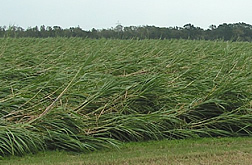This page has been archived and is being provided for reference purposes only. The page is no longer being updated, and therefore, links on the page may be invalid.
|
Read the magazine story to find out more. |
|
|
|
|
Advice for Hurricane-Harassed Sugarcane Growers
By Erin PeabodyFebruary 21, 2007
In 2005, Louisiana's sugar farmers had more than their usual share of challenges, which typically include pesky insects, weeds and diseases. On August 29, Hurricane Katrina made landfall, hurling 75-mile-per-hour winds over cane-growing parishes across the southern part of the state and bringing new problems to already-challenged sugarcane producers.
Giving these growers a helping hand with recovery are scientists at the Agricultural Research Service's (ARS) Sugarcane Research Laboratory in Houma, La. Under the direction of research leader Ed Richard, the laboratory's scientists and technicians have been offering their best advice on how to manage wind-warped and submerged cane.
According to Ben Legendre, a former ARS sugarcane researcher now working at the Louisiana State University AgCenter in St. Gabriel, more than 300,000 acres of cane were affected by the storm.
Katrina's severe winds and rains pummeled the state's 8- to 10-foot-tall sugarcane plants. Tops were sheared off, and wide swaths of cane were flattened as if steamrolled.
Then, in a double whammy, Hurricane Rita struck. That storm's tidal surge pushed eight to 10 feet of water several miles inland and flooded more than 35,000 acres of cane. Many fields remained under water for more than four days.
With the help of special federal emergency funds from U.S. Department of Agriculture agencies, hard-hit growers are getting back on their feet now, trying to recover from the estimated $280 million worth of damage.
The ARS sugarcane laboratory in Houma is also providing aid in the form of research-based advice for growers whose fields were inundated with salt water. According to Richard, it's hard to predict how these plants will do during the next couple of years. That's frustrating for growers, since sugarcane is a perennial plant that most had expected would produce a solid four years of harvest.
Houma scientists are also discussing pest-management options with growers, since the pervasive flooding also killed many beneficial predatory insects.
Read more about this work in the February 2007 issue of Agricultural Research magazine.
ARS is USDA's chief scientific research agency.

